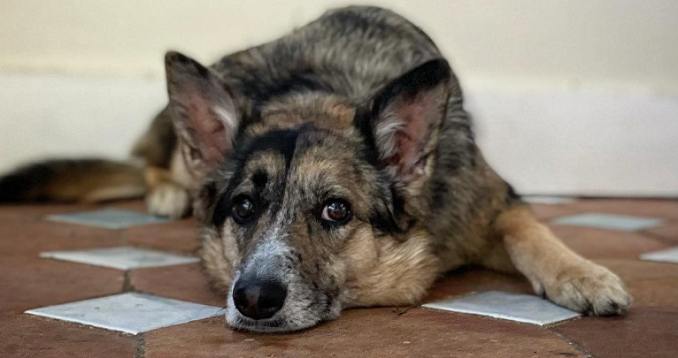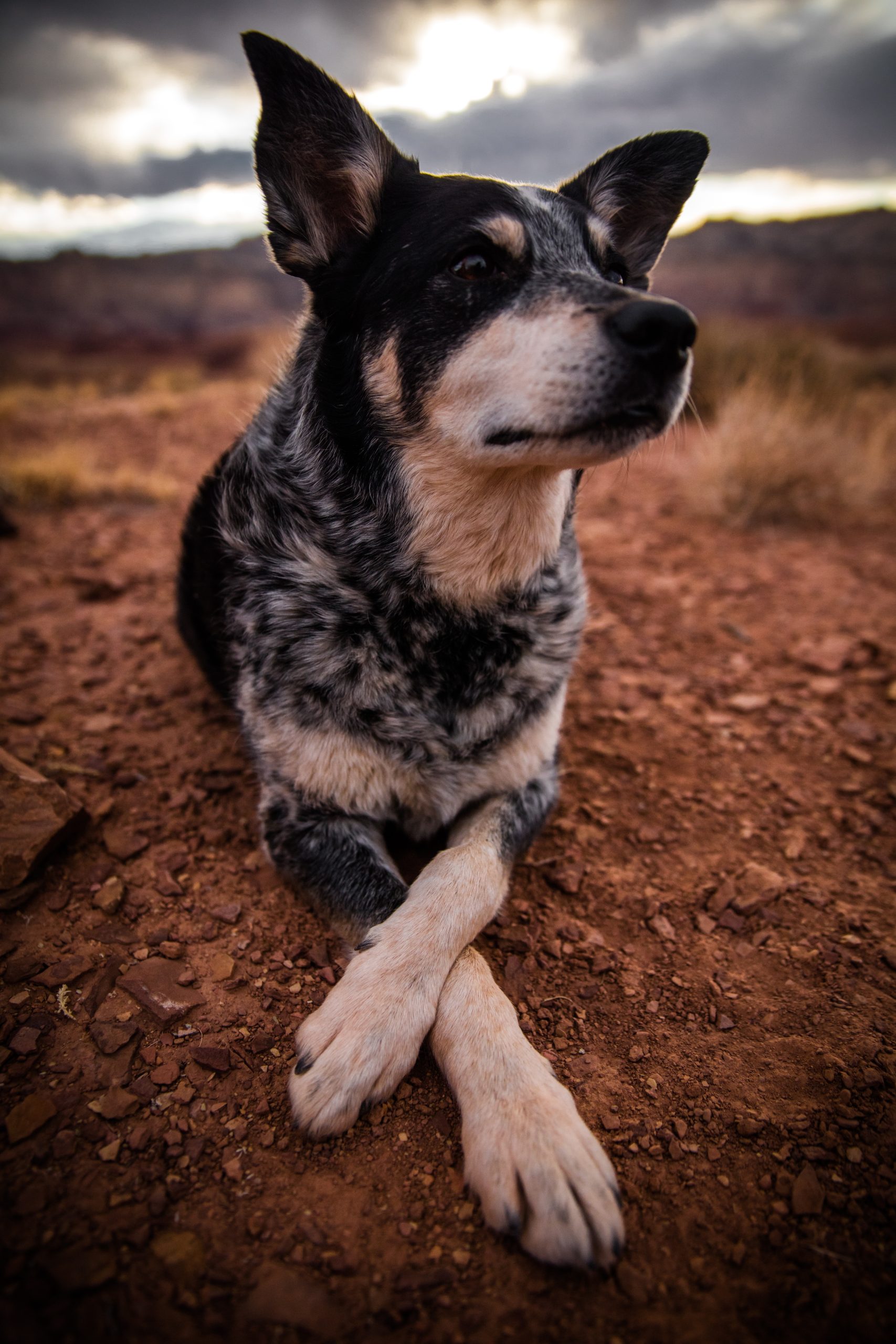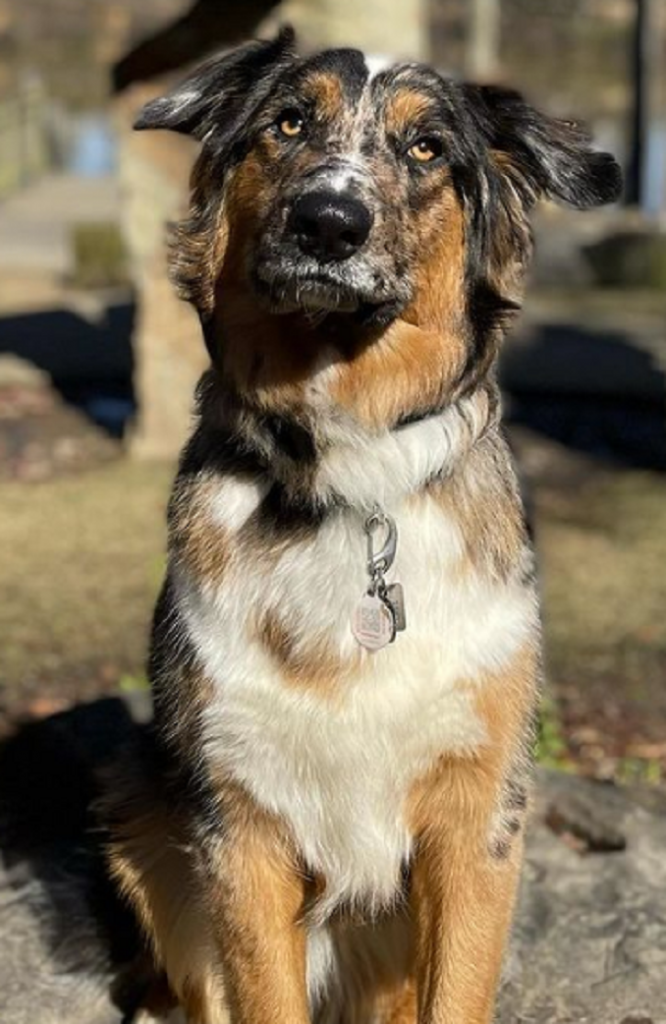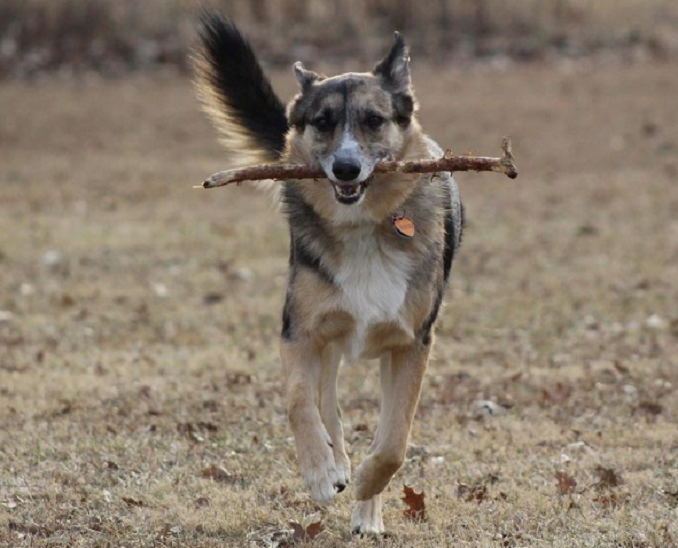The German Shepherd Australian Shepherd Mix is a cross between a German Shepherd and an Australian Shepherd. This crossbreed is also known as the German Australian Shepherd or Aussie German Shepherd.
These dogs have lively, affectionate personalities and agile, well-built bodies. German Australian Shepherds have an average life expectancy of 12 to 15 years and are medium to large, growing up to 26 inches and weighing around 45 to 80 pounds.
Families with active lifestyles are ideal for this energetic working dog. However, German Australian Shepherds are prone to separation anxiety, so they’ll need an owner who can give them lots of attention and be with them throughout the day. Read on for more facts about this breed.
TABLE OF CONTENTS
- German Shepherd Australian Shepherd Mix Quick Summary
- German Shepherd Australian Shepherd Mix Parent Breeds
- German Shepherd Australian Shepherd Mix History
- Taking Care of an Australian Shepherd German Shepherd Mix
- German Shepherd Australian Shepherd Mix Health Issues
- German Shepherd Australian Shepherd Mix Cost
- Should You Get a German Shepherd Australian Shepherd Mix?
- FAQs on German Australian Shepherds
- To a Lasting Bond with Your German Australian Shepherd
German Shepherd Australian Shepherd Mix Quick Summary
German Shepherd Australian Shepherd Mix Parent Breeds
The Australian German Shepherd is a relatively new crossbreed and its exact origins are unknown. However, this crossbreed’s parents are both working dogs originally developed for herding.
German Shepherds originate from Germany and were first bred in the late 19th Century, while Australian Shepherds originate from the western United States. Today, both breeds are still used as working dogs but have also become popular companion dogs because of their affectionate and loyal natures.
The Australian German Shepherd Mix takes on attributes and personality traits from both parent breeds, so it’s important to be familiar with each breed before considering this dog.
The German Shepherd
Origin
The German Shepherd, a breed known for its loyalty and versatility, originated in Germany in the late 19th century. Initially bred for herding and guarding sheep, the breed’s intelligence and trainability quickly made it a favorite for various roles, including police and military work, search-and-rescue operations, and as a service dog.
Physical Characteristics
German Shepherds are large dogs with medium-length double coats, square muzzles, broad heads, and muscular builds. Their physical prowess is matched by their striking appearance, often characterized by a mix of tan, black, and sometimes sable coloring. Their double coat, consisting of a dense outer layer and a softer undercoat, provides insulation and protection against various weather conditions.
Temperament and Behavior
While intelligent and typically eager to please, German Shepherds can sometimes be stubborn and require an owner who can provide firm and consistent training. They are known for their high energy levels and need for regular mental and physical stimulation. German Shepherds make great watchdogs due to their protective nature and strong guarding instinct. They tend to be aloof with strangers but are extremely loyal and affectionate with their family members. Early socialization and training are crucial for this breed to ensure they grow into well-adjusted adults.
The Australian Shepherd
Origin
Despite its name, the Australian Shepherd, often called an Aussie, did not originate in Australia but rather in the western United States during the 19th century. The breed was developed primarily for herding livestock. Its name is believed to have been inspired by the imported sheep that these dogs herded, which came from Australia.
Physical Characteristics
Australian Shepherds are medium-sized dogs with agile bodies, known for their unique and often striking coat colors, including blue merle, red merle, black, and red, often with white and tan markings. They have straight or wavy coats that are weather resistant, helping them to perform in various climates. Their eyes are a distinctive feature, which can be blue, brown, amber, or even a combination, adding to their expressive appearance.
Temperament and Behavior
Most Australian Shepherds are protective and good with kids, though some can be reserved around strangers. They are renowned for their intelligence and versatility, excelling in various canine sports and activities. Training Australian Shepherds is easy because they’re smart and eager to please, making them ideal for obedience, agility, and other training activities.
Their high energy levels and mental agility mean they thrive best in active homes where they can get plenty of exercise and mental stimulation. Early socialization and training are key to harnessing their potential and preventing the development of unwanted behaviors.
From Adobe Stock
German Shepherd Australian Shepherd Mix History
Origin
It emerged relatively recently in the world of dog breeding. While its exact origin is not well-documented, this mix likely originated in the United States within the last few decades, as the popularity of designer breeds began to rise. This crossbreed was created to combine the best traits of both parent breeds: the intelligence and versatility of the German Shepherd and the agility and herding abilities of the Australian Shepherd.
German Shepherd Australian Shepherd Physical Characteristics
Australian German Shepherds are medium to large dogs that take on a combination of physical traits from both of their parent breeds. Most have tapered muzzles, muscular builds, and medium-length coats.
Size and Weight
The Australian German Shepherd is considered a medium or large dog, with a height at the withers of 19 to 26 inches and an average weight between 45 and 80 pounds. The actual weight and height of the dog depend on the size of its parents and lifestyle factors such as their diet and activity level. Females are typically smaller than males.
German Shepherd Australian Shepherd Mix puppies weigh around 8 to 14 pounds at 12 weeks and reach their full adult size within 18 months.
Coat
Australian German Shepherds have medium-length double coats. While the coat’s appearance depends on the parents, most Australian German Shepherds have straight or wavy hair with a thick undercoat. Some of these dogs have an attractive mane of fur around their necks.
Colors
The German Shepherd Australian Shepherd Mix dogs come in shades of black, white, tan, red merle, blue merle, cream, and sable. Some Australian German Shepherds have white or tan markings on their muzzle, chest, stomach, paws, and eyes.
The coat can be solid white, red, or black in rare cases. Dogs with merle coloration are more prone to health issues like congenital deafness and blindness.
Face
The German Shepherd Australian Shepherd Mix has a broad-shaped head, tapered muzzle, and almond-shaped eyes that are amber, brown, or blue with an alert but friendly gaze. This breed’s ears are set high on their head. Some crossbreeds inherit the Australian Shepherd’s distinctive floppy ears, while others take on the German Shepherd’s erect, triangular ears.
German Shepherd Australian Shepherd Mix Personality and Temperament
Australian German Shepherds are loyal, affectionate, sociable, and intelligent. Like most herding dogs, German Shepherd Australian Shepherd mixes are energetic and love having a job to do.
Australian German Shepherds are fantastic watchdogs because of their strong guarding instincts. However, their protective nature can make these dogs fearful around strangers, especially if they haven’t been exposed to lots of people as a puppy.
While devoted to their owners, Australian German Shepherds can be stubborn if training is not consistent and clear. The best owner is prepared to dedicate time to the dog’s training and care. Australian German Shepherds are high-energy dogs and need to be cared for by someone who leads an active lifestyle.
Australian German Shepherds often experience separation anxiety and therefore shouldn’t be left alone for long periods. Without enough attention during the day, these dogs become destructive, anxious, and may bark excessively.
Taking Care of an Australian Shepherd German Shepherd Mix
Caring for an Australian German Shepherd dog is relatively difficult because of their high-maintenance coats, dietary needs, and activity level. They require a nutrient-rich diet and plenty of mental stimulation to keep their minds healthy and active. Here’s more.
Feeding
Understanding the dietary needs of a German Shepherd Australian Shepherd Mix is crucial for their health and well-being. I’m acutely aware of the importance of a well-balanced diet tailored to the needs of large, active breeds like the German Shepherd Australian Shepherd Mix since my family had a German Shepherd growing up.
Feeding Schedule
Adult Australian German Shepherds typically need between 2.5 and 3.5 cups of dog food per day, divided into two separate meals. This breed thrives on a routine, so it’s essential to maintain a consistent feeding schedule. Morning and evening meals help regulate their digestion and keep their energy levels steady throughout the day.
Portion Control
Portion control is vital for this mix, especially considering their size, metabolism, and activity level. Overfeeding can lead to obesity, while underfeeding might not meet their energy requirements. The exact amount depends on factors like age, activity level, size, metabolism, and physique. Regular check-ins with a vet can help determine the right portion size for your dog.
Treats and Snacks
While treats are an excellent tool for training, they should be given in moderation. Treats and snacks should not make up more than 10% of your dog’s daily calorie intake. Opt for healthy options like small pieces of cooked lean meats, fruits, and vegetables that are safe for dogs.
Special Dietary Considerations
Australian German Shepherds do best on a protein-rich diet that accounts for their high activity level. These dogs are fast eaters, so they’re prone to bloat, a serious health concern. To mitigate this risk, it’s advisable to use a puzzle bowl to slow their eating down. Also, be mindful of any food allergies or sensitivities, and adjust their diet accordingly with the guidance of a veterinarian.
Hydration
Adequate hydration is as important as a proper diet. Ensure your Australian German Shepherd has constant access to fresh, clean water. This is especially important for active dogs, as they can get dehydrated quickly after exercise or play.
Grooming
Grooming is an essential aspect of caring for a German Shepherd Australian Shepherd Mix. As someone who has raised Labradors, I understand the importance of regular grooming not only for the dog’s appearance but also for their overall health. Proper grooming helps in shedding management, skin health, and can even be a bonding experience between you and your dog.
Coat Care
The grooming needs of the Australian German Shepherd depend on the coat type the dog inherited from its parents. Most dogs in this mix have straight double coats with dense undercoats that shed moderately all year round and require brushing at least three times weekly.
During their bi-annual coat-blowing periods, these dogs require daily brushing. Always brush in the direction in which the hair grows and use a slicker brush to tackle tangles and mats. This routine not only keeps their coat healthy but also helps to distribute natural skin oils throughout their fur.
Bathing
While their coats tend to resist dirt, Australian German Shepherds still need monthly washing to keep their skin and fur healthy. It’s important to use a dog-specific shampoo that’s gentle on their skin and to ensure they’re thoroughly rinsed to prevent irritation.
Nail Trimming
Regular nail trimming is crucial to prevent discomfort and potential health issues. If you hear their nails clicking on the floor, it’s time for a trim. For those not comfortable doing this at home, a professional groomer or vet can assist.
Dental Care
Teeth cleaning is another vital part of grooming. Regular brushing of your dog’s teeth can prevent dental disease, which can lead to serious health complications. Using dog-specific toothpaste, aim to brush their teeth several times a week.
Ear Care
Checking the ears regularly for wax buildup or signs of infection is important. Clean them gently with a vet-approved solution and a cotton ball to prevent ear problems, which are common in dogs with floppy ears.
Training & Exercise
Training
The German Shepherd Australian Shepherd Mix can pick up new tricks and commands quickly. The dog is happiest when given a job to do and excels at focused activities such as scent work, agility, herding, and protection work.
Since this crossbreed is incredibly intelligent and work-focused, training can begin as early as 8 weeks old. Start with crate training, house training, and socialization, which involves exposing your puppy to new sights, smells, sounds, and surroundings to help it become a confident adult. Separation anxiety is common in this crossbreed, so you should also help the dog become accustomed to being alone from an early age.
Starting at three months old, begin basic obedience training and leash training. Positive reinforcement is the best training approach for a German Australian Shepherd because punishment often causes stress and fear. Adhere to a daily training schedule, and be firm and confident when teaching your dog new things.
Exercise
Australian German Shepherds are energetic dogs that require at least 90 minutes of exercise per day, ideally split into two separate walks. This crossbreed is intelligent, alert, and enjoys having a job to do, which makes them particularly well-suited to activities like agility and herding. Swimming is a great activity for senior Australian German Shepherds because it works out their bodies while relieving pressure from their joints.
Australian Shepherd German Shepherd mixes do best in households with large backyards as they need lots of space to run around. Without daily exercise, this crossbreed becomes restless and often turns to unwanted behaviors to get out excess energy.
Mental Stimulation
The Australian Shepherd German Shepherd Mix needs at least 60 minutes of mental stimulation per day to stay happy and mentally fit. Puzzle toys are a great way to stimulate this dog because it excels at problem-solving and loves a challenge.
Learning new tricks and commands and playing with interactive toys are other great ways to meet the Australian German Shepherd’s mental needs.
German Shepherd Australian Shepherd Mix Health Issues
German Australian shepherds are relatively healthy, with an average lifespan of 12 to 15 years. However, the dogs are affected by many of the conditions their parent breeds are prone to, including the following:
Hip dysplasia
A pet with this problem has an abnormal formation of the hip joint which causes mobility issues, lameness, and pain. Hip dysplasia is treatable and managed with weight reduction, physical therapy, medication, and surgery. In some cases, lifestyle modifications like using orthopedic beds and avoiding high-impact activities can also help alleviate symptoms.
Elbow dysplasia
It’s similar to hip dysplasia but affects the dog’s elbow sockets. The condition causes pain, swelling, mobility issues, and can lead to arthritis. Elbow dysplasia is treated with the same measures as hip dysplasia, including joint supplements and anti-inflammatory drugs to manage pain and improve joint function.
Cataracts
It’s a condition where the lens of the eye becomes clouded, causing vision issues. Surgery can remove cataracts by removing the cloudy lens and, in many cases, replacing it with an artificial one. Dogs with cataracts may exhibit signs like noticeable cloudiness in the eyes, clumsiness, or reluctance to climb stairs or jump. While cataracts are commonly associated with aging, they can also be caused by genetics, diabetes, or trauma to the eye. Early surgical intervention is often recommended to prevent further deterioration of vision.
PRA
Progressive Retinal Atrophy (PRA) is a severe genetic condition that leads to the degeneration of retinal cells. PRA causes irreversible blindness and can’t be treated, but early diagnosis can help manage the progression and prepare for the dog’s changing needs.
Bloat
A dangerous condition that causes the dog’s stomach to rapidly fill up with gas or fluid and twist and distend. Bloating can be fatal and requires emergency treatment immediately. Preventative measures include feeding smaller, more frequent meals and avoiding vigorous exercise around meal times.
Allergies
German Shepherd Australian Shepherd mixes may also be prone to allergies, which can manifest as skin irritations, ear infections, or gastrointestinal problems. Allergies can be triggered by environmental factors, food, or fleas. Treatment typically involves identifying and avoiding the allergens and may include medication for symptom relief.
Degenerative Myelopathy
This progressive neurological disorder can affect this mix, particularly in the later years. It leads to weakness and paralysis in the dog’s hind legs. While there’s no cure, supportive care can help maintain quality of life.
Some problems affect some dogs. For example, Merle German Australian Shepherds may have health issues like eye and ear problems because the merle color pattern is a genetic mutation. Hence, always look for breeders who are happy to provide you with the parents’ health screenings.
German Shepherd Australian Shepherd Mix Cost
German Shepherd Australian Shepherd Mix dogs are relatively affordable. The initial price depends on whether you buy them from a breeder or choose to adopt an adult dog.
How Much is a German Shepherd Australian Shepherd Mix?
A German Shepherd Australian Shepherd Mix bought from a breeder costs $300 to $800 USD. The exact price of an Australian German Shepherd puppy depends on its appearance and lineage. Puppies with rare coloration, like solid white or black, tend to be the most expensive.
Adopting an adult dog is much cheaper than buying from a breeder. Adoption fees typically range between $150 and $300. However, Australian German Shepherds are rarely put up for adoption and can be difficult to find in rescue shelters.
How Much Does it Cost to Raise a German Shepherd Australian Shepherd Mix?
The monthly cost of raising a German Shepherd Australian Shepherd Mix is $85 to $160 on average, which covers expenses such as food, grooming supplies, healthcare, and toys.
The first year is more expensive than other years because owners must buy initial pet supplies like bedding and walking equipment. Training classes, pet sitters, and professional grooming trips will also increase the monthly costs of raising an Australian German Shepherd Mix.
Should You Get a German Shepherd Australian Shepherd Mix?
The German Shepherd Australian Shepherd Mix is an intelligent and affectionate dog that makes a wonderful family pet. However, the crossbreed’s high energy level, proneness to separation anxiety, and strong guarding instincts mean it isn’t suitable for all people or lifestyles.
German Shepherd Australian Shepherd Mixes are Suitable for:
German Shepherd Australian Shepherd mixes are well-suited to active families who are prepared to groom, exercise, and train a dog regularly. Households with large backyards are best for these dogs because of their high energy level, but they can still live in apartments if they’re taken out for regular exercise.
German Australian Shepherds are particularly ideal companions for those wanting a family watchdog because of their protective nature and strong guarding instincts.
German Shepherd Australian Shepherd Mixes are NOT Suitable for:
The German Shepherd Australian Shepherd Mix isn’t suitable for inactive people or people with mobility issues. This crossbreed often suffers from separation anxiety if left alone for long periods, so the dog needs an owner who can be with them throughout the day.
Families with young children should avoid this crossbreed because the dog may accidentally knock down kids while playing. Since the German Australian Shepherd needs lots of attention, playtime, and training, the breed isn’t suitable for people who lead busy lifestyles.
German Australian Shepherds are sometimes reserved around strangers and therefore prefer a home environment where they won’t be constantly exposed to new faces.
FAQs on German Australian Shepherds
How much exercise does this breed need?
Due to their high energy levels and active nature, the German Shepherd Australian Shepherd Mix requires significant daily exercise. They thrive on activities like long walks, runs, hikes, and playtime in a secure area. Mental stimulation through training exercises and puzzle toys is also crucial for their well-being.
Are they good family dogs?
Yes, when properly socialized and trained, the German Shepherd Australian Shepherd Mix can make an excellent family pet. They are known for their loyalty and protective nature, making them great watchdogs. However, their size and energy level should be considered, especially in households with small children.
What are the grooming requirements?
Their grooming needs vary depending on the coat they inherit from their parents. Typically, they have a double coat that sheds moderately throughout the year, requiring regular brushing. During shedding seasons, daily brushing may be necessary. They also require routine baths, nail trims, ear cleaning, and dental care.
How easy are they to train?
These dogs are generally easy to train due to their intelligence and eagerness to please. They respond well to positive reinforcement techniques such as treats and praise. Consistency and patience are key in training, as is early socialization to ensure they grow into well-adjusted adults.
What health issues should I be aware of?
Like all breeds, the German Shepherd Australian Shepherd Mix can be prone to certain health issues. Common concerns include hip dysplasia, elbow dysplasia, and bloat. Regular veterinary check-ups and a healthy lifestyle can help mitigate these risks. It’s also important to know the health history of their parents.
What kind of diet is best for this breed?
A high-quality, balanced diet suited to their age, size, and activity level is best. These dogs typically do well on a diet rich in protein to support their active lifestyle. Portion control is important to prevent obesity, and their fast eating habits may require special feeding bowls to reduce the risk of bloat.
To a Lasting Bond with Your German Australian Shepherd
This unique hybrid breed is as delightful as it is demanding. My experience with Labradors has taught me the importance of understanding and meeting the specific needs of a dog breed, and this mix is no exception. They require dedicated training, ample exercise, and consistent grooming.
Embracing these needs will ensure that your German Shepherd Australian Shepherd Mix thrives and forms a deep, lasting bond with you and your family. Enjoy every moment of this rewarding experience, and cherish the love and loyalty your Australian German Shepherd will undoubtedly bring into your life.





Be the first to comment